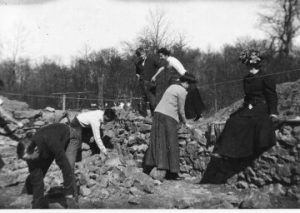The small village camp was sparse in first years. Within the next decade however, things began to change rapidly. Cabins and more permanent structures were built. The Arden Inn and The Spreading Oak began to house guests. By 1910, nearly all of the land parcels had been leased, with a stack of applications waiting to be filled.
One of the significant factors that contributed to the housing boom was the restructuring of the Arden system of governance. Shortly after the purchase of the Derrickson farm, the title to the land was transferred to a trust that was established to make sure that Arden would always be managed under single tax principles. This trust included just three men: Frank Stephens, Frank Martin, and William Price. Under this arrangement, the trustees would retain a nominal ownership of the land and would be legally responsible for all state and federal land taxes.
This arrangement was short-lived. Squabbling over land assessments was resolved during the 1905 yearly town meeting. This meeting led to the establishment of an informal government in 1905. By 1908, the community had ratified a constitution and by-laws. The constitution stated that Ardenfolk or their elected officials would determine the rental value of each lot, instead of the three trustees. The by-laws created a board of seven elected assessors.
These yearly town meetings served another function beyond settling assessment disputes. Meetings served as civil government for the community and members practiced direct democracy. An arbitrary voting age was not established, due to Stephens’ view that it was nonsense, allowing anyone who was interested enough in attending a meeting to have a voice. The democratic activity of voting was extended to women and, as community lore has it, a few civic-minded infants.
Despite the rocky start and an on-going effort to maintain adherence to the single-tax philosophy, the community thrived. In 1922, the community expanded. Fiske Warren, a friend of Frank Stephens, provided a loan of $30,000 dollars towards the $39,000 needed to purchase a plot of land that included 97 acres of the Harvey farm and 12 acres of the Hanby farm. These farms were located to the southeast of Arden. The Deed of Trust for the newly-created Ardentown placed the assessment on land rents solely in the hands of the trustees. Frank Stephens, his son Donald, and William Worthington, Jr. served as the first trustees.
In 1950 the community once again expanded. Another 63 acres of farmland was purchased to create Ardencroft with money borrowed with a mortgage placed on Don Stephens’ real estate holdings in Arden. Stephens, Hamilton D. “Buzz” Ware, and Henry George III served as the original directors. Ardencroft differs from its sister communities in that it was established as a corporation instead of a trust.


